ISSN ONLINE(2319-8753)PRINT(2347-6710)
ISSN ONLINE(2319-8753)PRINT(2347-6710)
Dr.Shivappa1, Ananda.G.K2, Shivakumar.N3
|
| Related article at Pubmed, Scholar Google |
Visit for more related articles at International Journal of Innovative Research in Science, Engineering and Technology
The present research work is more dedicated in the development of more and more natural fiber composites as it serves the purpose of industrial and domestic requirements with the use of bio degradable products. Bio degradable products like coconut coir, jute, and rice husk are naturally available and are not harmful to the nature like synthetic fiber. In this study, composites were prepared with unmodified Rice Husk Flour (RHF) as a filler and Unsaturated Vinlyester Resin (UVR) as the matrix. 0%, 2.5%, 7.5% and 10% by weight of filler percentages were used in order to gain insights into the effect of filler content on the mechanical properties (Tensile and Flexural) of the composite produced using Hand Layup method. Three samples of different percentage fractions are tested and SEM analysis made on samples. With this study we come to know the compatibility of rice husk fiber with vinylester and contribution in the mechanical property of a matrix.
Keywords |
| Vinylester, Rice Husk Flour, Tensile and Flexural Strength of RHF/VE |
I. INTRODUCTION |
| Natural polymers are more in concern in the research work as they are naturally and abundantly available and cheap compare to synthetic fiber. Rice husk is used more as a fuel for burning and to some extent its ash is used as admixture in concrete making rather it can be used to prepare a composite to enhance the property of a matrix material which is made available for various applications that may be industrial, constructional, or automotive area. Hardinnawirda [1] studied that with the addition of rice husk filler there is decrease in tensile strength of the composite and its water absorption increases as it absorbs water. D Lingaraju [2] studied on rice husk ash Nano composite using burnishing processes which is increased the hardness of composite material with the increase of depth cut and also smoothen the surface, Treated RHA has good influence on hardness than non-treated RHA.Francis Uchenna OZIOKO studied The effect of carbonization temperatures on wear rate behaviours of different volume fractions of rice husk ash epoxy composite. Wear rate and specific wear rate behaviours of different samples have shown near uniform behaviour. The 950°C carbonized ash showed steady wear rate and specific wear rate behaviour for all ash contents’. Dimzoski [4] studied properties of rice-hull-filled polypropylene (PP) composites. Using the concept of linear elastic fracture mechanics, Introduction of rice hulls in the PP matrix resulted in a decreased stress at peak , together with increase of composites tensile modulus and modulus in flexure.D.Shivaprasad [5] studied As the percentage of RHA particles increases, the density of the composites decreases and there is slight increase in the hardness were observed.Sudhakar Majhi [6] studied that the abrasive wear rate decreases with addition of rice husk fibers as the sliding distance increases for all wt.% of fibers including pure epoxy. It is also observed that 10wt%fiber shows least wear rate. Higher wt.% of fiber also shows lower wear rate but higher than 10wt%, still lower than pure epoxy.Han-Seung Yang [8] The tensile strength and modulus of the bio composites fabricated using the twin-screw extruding system were improved as compared with those fabricated using the single-screw extruding system, due to the improved dispersion of the fillers in the composite. There was no difference in the Izod impact strength of the composites fabricated using the twin-screw and single-screw extruding systems.Patricio Toro [11] the increase of the rice-husk charge as a natural filler in the PP matrix decreases the stiffness, and in the presence of PP-g-MMI as compatibilizer in PP/rice-husk, the tensile modulus and water absorption of the composite were improved. In this study two natural fibers (coir and rice husk) are used to prepare a hybrid material to enhance the property of composite which contains only one fiber and fails to give mechanical strength at particular percentage addition of fiber from that point of yield one more fiber (rice husk) is added to increase its property further to some extent. The fabrication process is hand layup and mechanical tests are tensile and flexural. |
II. EXPERIMENTAL WORK |
| A. Preparation of test samples |
| Finely milled rice husks were collected from a local rice mill. The milled rice husks contain many impurities like dust, small rice particles, and fine sand particles. Therefore, it needs to be cleaned in order to get pure rice husk. After cleaning with water, the rice husks were dried directly under the sun for 8 hours. Then it were weighted according to the percentage needed (10, 15, 20 and 25 wt. %). After that, the unsaturated polyester resin and methyl ethyl ketone peroxide (MEPK) catalyst were mixed in a container and stirred well for 3 to 5 minutes. The rice husks were then added gradually and stirred to allow proper dispersion of fibre within the gel like mixture. Before the mixtures were poured inside the mould, the mould was initially polished with a release agent to prevent the composites from sticking to the mould upon removal. Finally, after the mixture had been poured into the mould, it was left at room temperature for 24 hours for fully cured and hardened. The materials used in the present research are tabulated in Table.1 with their properties and suppliers. |
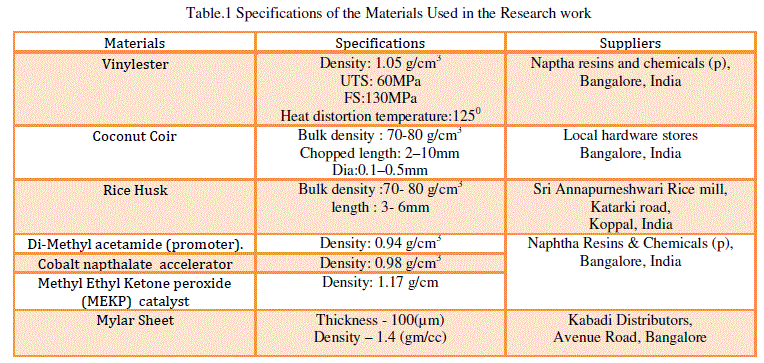 |
| B . Mechanical characterization |
| The Processing Procedure of Coir / Vinylester Cut the Mylar sheet according to mould size and place it on the mould.According to calculation pour the resin into the mug.According to the percentage of weight required the calculated amount of rice husk is mixed into the resin. Stir well for about two minute in clockwise and alternatively anticlockwise to mix the content throughly. Then add hardeners i.e. promoters, accelerators and catalyst of 1 % or 2% depending of volume fraction. Once it is mixed thoroughly now it is ready to lay on the mould.Before layup clean the Mylar sheet with little amount of resin.Pour the mixer continuously over the mold apply little pressure using plates to fill the mixer all along the mold.Wait for a minute and apply pressure using hand rollers to remove air bubbles and to maintain uniqueness in the laminate.Once the layup is over put Mylar sheet on it to avoid sticking of specimen onto the male portion of the mold and put heavy weight on the specimen and leave it for curing. Approximately after 24 hour at room temperature the laminate is ready for cutting operation. The specimen is cut to the desired size and taken for testing. The samples were tested for mechanical tests that are tensile and flexural strength using universal 2001E UTM machine from blue star company according to ASTM standards. Samples of 0, 2.5, 5, 7.5 wt. % of fibre of size 250x25x10mm are cut to the ASTM D3030 standard from each percentage three sample are tested and its average value is taken for evaluation. The flexural test for three point bending test is conducted as per ASTM D790 to each percentage variations. The size of each testing sample is 200x15x10 mm. |
| C . Samples preparation calculations |
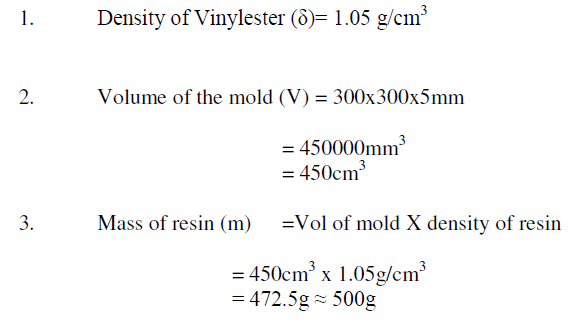 |
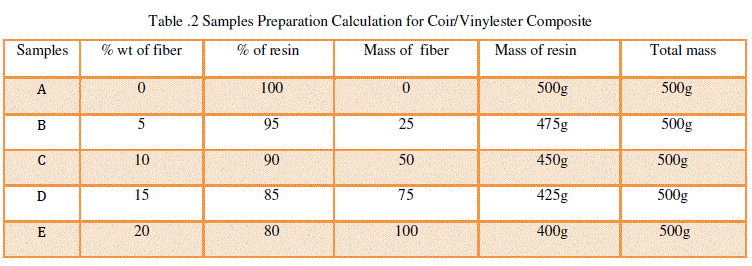 |
| The above samples are tested for mechanical properties that are tensile and flexural strength according ASTM standards. |
| D. Testing parameters |
| A Universal Testing Machine (UTM) is an instrument used for the measurement of loads and the associated test specimen deflections such as those encountered in tensile, compression or flexural modes. It is used to test the tensile, compression, flexural and Inter Laminar Shear Strength (ILSS) properties of materials. Load cells and extensometers measure the key parameters of force and deformation as the sample was tested. The Universal Testing Machine set up is shown in Fig.1 |
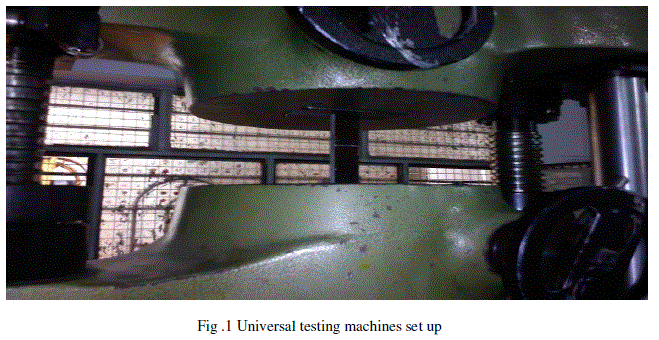 |
| Composite materials were subjected to various mechanical tests to measure strength, elastic constants, and other material properties. The results of such tests were used for two primary purposes: 1) engineering design (for example, failure theories based on strength, or deflections based on elastic constants and component geometry): 2) quality control either by the materials producer to verify the process or by the end user to confirm the material specifications. |
III. RSULTS & DISCUSSION |
| A. Morphological Characteristics |
| Nano level materials cannot be observed through optical microscope due to their aberrations and limit in wavelength of light. Therefore to observe submicron sized particles advanced techniques such as Scanning Electron Microscopy (SEM), Transmission Electron Microscopy (TEM), Scanning Tunnelling Microscopy (STM), and Atomic Force Microscopy (AFM). In this work, the dispersion of Cloisite-15A in vinylester resins was studied using SEM. The basic principles of these techniques are presented in the subsequent sections. Fig.3 shows the SEM micrograph of tensile fractured specimen of neat vinyl ester smooth surface and the size is higher. With the addition of RHF the smooth surfaces sizes are reduced and the reduction was increased with the increase of RHF addition. The smooth area represents the voids at higher concentration of Cloisite-15A the number of voids are more. |
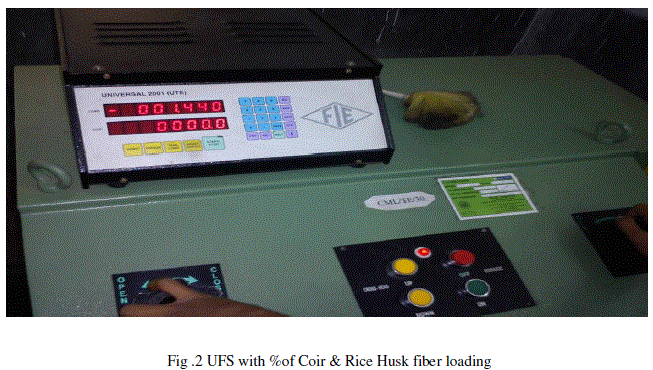 |
| From the microstructure it is evident that there is inhomogeneous mixture of RHF/Vinyl ester that leading to some voids/pores in the matrix as shown in fig.4. There are some micro cracks in the matrix material which is responsible for reduction of tensile strength of the composite as seen in fig.5. There is gap surrounding the reinforcement indicating the poor bonding reinforcement and matrix. Poor interfacial bonding results decrease in strength of composite. Only in case of 7.5% filler loading as shown in fig.6. It is found to have good interfacial bonding and no micro cracks which has given the concrete little positive strength to the tensile load. |
| B . Ultimate tensile strength (UTS ) |
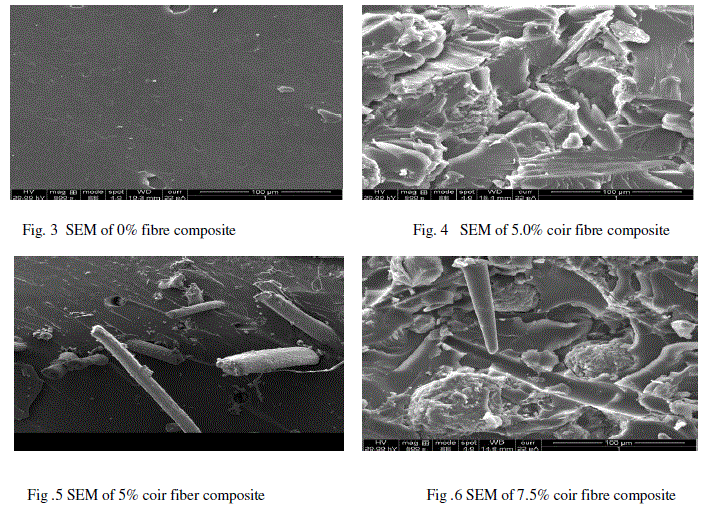 |
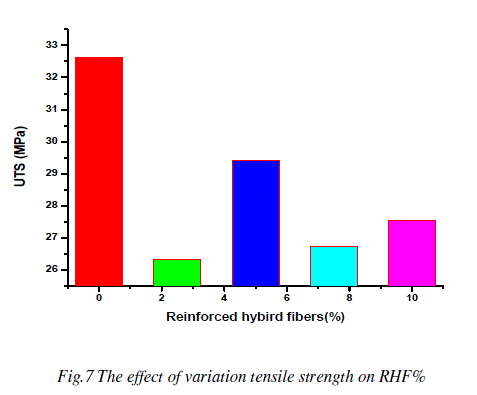 |
| The fig.7 shows that the effect of variation ultimate tensile strength on reinforced hybrid fibers composites are 0%, 2.5%,5%,7.5% ,10% are respectively.The ultimate tensile strength is obtained at 0% addition of reinforced hybrid fibers composites is 32MPa.The addition of 5% RHF composites its obtained 29MPa .The fig.8 shows that effect of variation ultimate flexural strength on reinforced hybrid fibers composites are 0%, 2.5%,5%,7.5% ,10% are respectively.The ultimate flexural strength is linearly increases as increases reinforced hybrid composites. The higher ultimate flexural strength is obtained at 10% RHF. |
IV. CONCLUSION |
| The conclusion of the study of Coir & Rice Husk reinforced vinyl ester composite is that there is significant increase in the flexural strength of the composite whereas it loses its tensile strength at 20% fiber loading. Flexural strength of the composite increases as the fibre loading increased. |
| a) Tensile strength of the fiber increased by 27.80% and again decreases by 20.85% for fiber loading of 20% respectively: b) Tensile strength of the composite increased 51.63% by adding the Rice Husk in 1,3 & 5%: c) Flexural strength of the composite increased by 42.17% with addition of coir fiber alone: d) Whereas when the rice husk is added to coir the flexural strength increase by 48.4% for the fiber loading of 1, 3 & 5% of rice husk.: e) SEM analysis report clearly shows that there voids/pores, micro cracks and poor bonding of matrix with reinforcement: f) Random oriented coir fiber–polyester composites are low-strength materials, but can be designed to have a set of flexural strengths that enable their use as non- structural building elements. |
V. ACKNOWLEDGMENT |
| The authors gratefully thanks to timely help rendered by the staff members of Department of Mechanical Engineering GSSIT, Bangalore. |
References |
|